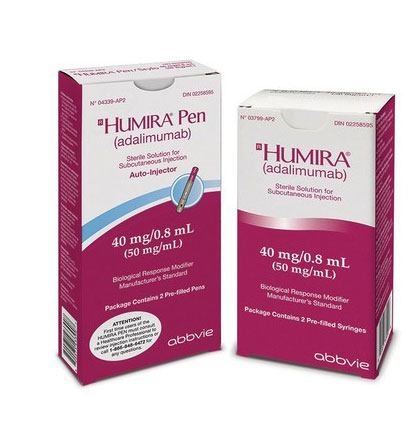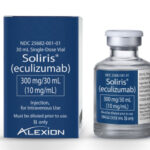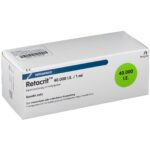Humira: Uses, Benefits, How it works, Side Effects, Cost

What is Humira used for?
Humira is a brand of Adalimumab a disease-modifying antirheumatic drug and monoclonal antibody that acts on the immune system and is used to treat the following conditions:
• plaque psoriasis, a disease causing red, scaly patches on the skin
• psoriatic arthritis (red, scaly patches on the skin with inflammation of the joints)
• rheumatoid arthritis (a disease causing inflammation of the joints)
• axial spondyloarthritis (inflammation of spine causing back pain), including ankylosing spondylitis and when X-ray does not show disease but there are clear signs of inflammation
• Crohn’s disease (a disease causing inflammation of the gut)
• ulcerative colitis (a disease causing inflammation and ulcers in the lining of the gut)
• polyarticular juvenile idiopathic arthritis and active enthesitis-related arthritis (both rare diseases causing inflammation in the joints)
• hidradenitis suppurativa (acne inversa), a chronic skin disease that causes lumps, abscesses (collections of pus), and scarring on the skin
• non-infectious uveitis (inflammation of the layer beneath the white of the eyeball).
Humira is mostly used in adults when their conditions are severe, moderately severe or getting worse, or when patients cannot use other treatments. For detailed information on the use of Humira in all conditions, including when it can be used in children, see package leaflet or contact your doctor or pharmacist.
How does Humira work?
The active substance in Humira, adalimumab, is a monoclonal antibody (a type of protein) that has been designed to recognize and attach to a substance in the body called tumor necrosis factor (TNF). This substance is involved in causing inflammation and is found at high levels in patients with the diseases that Humira is used to treat. By attaching to TNF, adalimumab blocks its activity, thereby reducing inflammation and other symptoms of the disease.
Is Humira safe?
Yes, Humira has been studied extensively and has been shown to be safe and effective at reducing symptoms in patients with inflammatory conditions. Some rare but serious side effects have been reported, including serious infections. However, these are considered to be manageable and specific recommendations are given to help doctors manage these risks.
How is Humira used?
Humira is given as an injection under the skin, usually every 2 weeks. The dose and frequency of injection depend on the condition to be treated and the dose for a child is calculated according to the child’s weight.
Treatment with Humira must be started and supervised by a doctor who has experience in the treatment of the diseases that Humira is used for. Doctors treating uveitis should also take advice from doctors who have experience of using Humira. Patients or their carers can inject Humira once they have been trained.
Humira can only be obtained with a prescription. For more information about using Humira, see the package leaflet or contact your doctor or pharmacist.
What is the success rate (remission rate) of Humira?
Studies have shown that about 40% of patients taking HUMIRA achieved reduction or disappearance of the signs and symptoms at 26 weeks, and 36% of those patients achieved and maintained remission at 56 weeks. Individual results may vary. So Humira does really work!
What benefits of Humira have been shown in studies?
More than twenty main studies involving over 9,500 patients have looked at the effects of Humira in reducing symptoms of inflammatory conditions. The studies included adult patients for the most part, but included children in studies for Crohn’s disease, ulcerative colitis, plaque psoriasis, polyarticular juvenile idiopathic arthritis, non-infectious anterior uveitis, and enthesitis-related arthritis.
Humira, when used as directed, has been shown in clinical trials to be effective at reducing important symptoms of each of the conditions for which it is approved. Below is a brief description of the studies and their results:
• In studies in adults and children with plaque psoriasis, including psoriasis of the nail, a higher proportion of patients receiving Humira had improvements in symptoms compared with patients receiving methotrexate or placebo (a dummy treatment).
• Humira produced a greater improvement in symptoms than placebo in studies of psoriatic arthritis, ankylosing spondylitis, axial spondyloarthritis without evidence in the X-ray of ankylosing spondylitis but with clear signs of inflammation, Crohn’s disease, and psoriasis.
• In studies in adults with ulcerative colitis, Humira produced a greater improvement in symptoms and healing of the mucosa (the lining of the gut) than placebo. Humira improved symptoms and mucosal healing in children aged 6 to 17 years with pediatric ulcerative colitis.
• In rheumatoid arthritis, the greatest reductions in symptoms were seen in the studies on Humira as an add-on to methotrexate: around two-thirds of the patients adding Humira had at least a 20% reduction in symptoms after six months, compared with a quarter of those adding placebo. Patients adding Humira also had less joint damage and less reduction in physical function after a year. In patients who had not taken methotrexate in the past, the combination of Humira and methotrexate was also more effective than methotrexate alone.
• In polyarticular juvenile idiopathic arthritis, around 40% of patients aged between 4 and 17 years receiving Humira, either alone or in combination with methotrexate, had a flare-up of arthritis, compared with around 69% of those receiving placebo. Fewer patients receiving Humira with methotrexate developed antibodies against Humira (which can reduce its effects), so the results found that the use of Humira with methotrexate was more effective than Humira used alone. The study in younger children (aged 2 to 4 years) showed that the majority of children responded well to Humira treatment and this response was maintained after 24 weeks. For enthesitis-related arthritis, treatment with Humira resulted in fewer swollen and tender joints compared with placebo.
• In hidradenitis suppurativa, 59% of patients receiving Humira in one main study and 42% of patients in another achieved at least a 50% reduction in abscesses and nodules after 12 weeks, without any increase in abscess count or fistulas. The proportions of patients taking placebo who achieved this goal were 28% in the first study and 26% in the second.
• In non-infectious uveitis, Humira was found effective in 3 studies. The first study involved adults whose disease was not controlled with high doses of corticosteroids. In this study, treatment failed in about 79% of patients receiving placebo compared with about 55% given Humira. The second study involved adults whose uveitis was under control with a corticosteroid but the corticosteroid dose was then reduced or stopped and Humira or placebo introduced. In this study, treatment failure occurred in about 55% of patients receiving placebo compared with 39% receiving Humira. In the third study in children aged 2 to 18 years with non-infectious anterior uveitis, in whom methotrexate alone did not work, treatment failed in about 60% of patients receiving placebo with methotrexate compared with about 27% of patients given Humira with methotrexate.
What are the risks and side effects associated with using Humira?
The most common side effects with Humira (which may affect more than 1 in 10 people) are infections (including in the nose, throat, and sinuses), injection site reactions (redness, itching, bleeding, pain or swelling), headache, and muscle and bone pain.
Humira and other medicines of its class may also affect the ability of the immune system to fight off infections and cancer, and there have been some cases of serious infections and blood cancers in patients using Humira.
Other rare serious side effects (which may affect up to 1 in 1,000 people) include failure of bone marrow to produce blood cells, nerve damage caused by the breakdown of the covering around the nerve fibers, lupus and lupus-like conditions (where the immune system attacks the patient’s own tissues, causing inflammation and organ damage), and Stevens-Johnson syndrome (a life-threatening reaction with flu-like symptoms and painful rash affecting the skin, mouth, eyes, and genitals). For the full list of side effects of Humira, see the package leaflet.
Humira must not be used in patients with active tuberculosis or other severe infections, or in patients with moderate to severe heart failure (an inability of the heart to pump enough blood around the body). For the full list of restrictions with Humira, see the package leaflet.
What other drugs interact with Humira (adalimumab)?
The following drugs can interact with Humira (adalimumab)
• Moderate interactions of adalimumab include:
o astragalus
o belatacept
o denosumab
o echinacea
o fingolimod
o hydroxyurea
o influenza virus vaccine quadrivalent, recombinant
o influenza virus vaccine trivalent, recombinant
o maitake
o meningococcal group B vaccine
o mercaptopurine
o sipuleucel-T
• Mild interactions of adalimumab include:
o cat’s claw
What measures are being taken to ensure the safe and effective use of Humira?
Patients treated with Humira must be given a reminder card with information on the safety of the medicine. Recommendations and precautions to be followed by healthcare professionals and patients for the safe and effective use of Humira have also been included in the summary of product characteristics and the package leaflet.
As for all medicines, data on the use of Humira are continuously monitored. Side effects reported with Humira are carefully evaluated and any necessary action taken to protect patients.
What is the Price of Humira Pen?
The average retail price of Humira is $10,945.13 while the lowest price for the most common version of Humira costs $5,808.72. In general, the average Humira cost for a 30-day supply of Humira is over $5,500 for cash-paying customers and prices only continue to increase.





